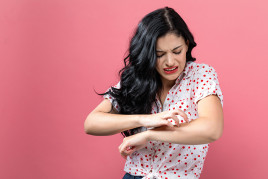Eczema types: Dyshidrotic eczema self-care
Moisturizer plays a key role in helping your skin heal
Dermatologists recommend using a fragrance-free cream or ointment. Avoid lotions, which can worsen dyshidrotic eczema because they contain too much water.

If you have dyshidrotic eczema, your skin needs gentle skin care and protection from anything that might irritate it. Here’s what dermatologists recommend does just that:
Remove your rings BEFORE you:
- Wash your hands
- Apply moisturizer
- Go to sleep
Wash skin with dyshidrotic eczema gently. When washing, you’ll want to:
- Remove rings: Always remove these before washing your hands. If the skin beneath gets wet and stays damp, this could cause a flare-up.
- Use lukewarm water: Using lukewarm water every time can help prevent flares.
- Wash with mild, fragrance-free cleansers: Skip the antibacterial soaps, and deodorant soaps, which can cause dyshidrotic eczema to flare.
Ask your dermatologist to recommend a hand sanitizer. If you have a hypersensitivity to an ingredient in a hand sanitizer, it can cause a flare-up.
Apply moisturizer (or barrier repair cream) frequently throughout your day. Dyshidrotic eczema leaves you with extremely dry skin. The best times to apply your moisturizer or barrier repair cream are:
- After washing
- Whenever your skin feels dry
Learn to manage stress really well. Some patients find that their skin clears with effective stress reduction and treatment prescribed by their dermatologist.
One stress reduction technique has proven especially effective in small studies. It’s called biofeedback therapy. Some patients have been able to clear their skin — and keep it clear — by practicing biofeedback therapy.Try to avoid scratching. Anything you can do to reduce scratching is helpful because scratching tends to worsen dyshidrotic eczema.
Take precautions in very dry or hot conditions. Heat, dryness, and sweat are known to trigger dyshidrotic eczema. Try to avoid getting overheated by staying cool. To protect your skin from becoming excessively dry, apply moisturizer frequently.
Avoid what causes an allergic reaction or irritates your skin. If either allergens or irritants are the problem, avoiding them may be necessary to clear your skin — and keep it clear.
If you’re uncertain about what can cause an allergic reaction or irritate your skin, see your dermatologist. Testing can help you know what to avoid.Protect your hands with gloves. Many things that touch your skin can cause dyshidrotic eczema to flare. Water, detergents, and household cleaners are a few. Even washing dishes or painting could cause dyshidrotic eczema to flare.
To protect your hands, dermatologists recommend that you put gloves on before you get your hands wet and before touching something that could irritate your skin.
You also want to wear the right glove for the job:- Your hands will stay dry: 100% cotton gloves
- Wet work: 100% cotton gloves under waterproof gloves. Wearing cotton gloves beneath your waterproof ones helps prevent irritation.
Wear moisture-wicking socks. If you have dyshidrotic eczema on your feet, this will help keep your feet dry.
Image
Getty Images
References
de Boer EM, Bruynzeel DP, et al. “Dyshidrotic eczema as an occupational dermatitis in metal workers.” Contact Dermatitis. 1988;19(3):184-8.
Habif TP, Campbell JL, et al. “Pompholyx” (card #16). In: Dermatology DDxDeck. Mosby 2006.
Miller JL, Hurley HJ. “Diseases of the eccrine and apocrine sweat glands.” In: Bolognia JL, Jorizzo JL, et al, [eds.] Dermatology. Mosby Elsevier 2008:543.
Written by:
Paula Ludmann, MS
Reviewed by:
Dara D. Spearman, MD, FAAD
Elaine T. Kaye, MD, FAAD
Emily Chu, MD, PhD, FAAD
Last updated: 11/16/20
 Atopic dermatitis: More FDA-approved treatments
Atopic dermatitis: More FDA-approved treatments
 Biosimilars: 14 FAQs
Biosimilars: 14 FAQs
 How to trim your nails
How to trim your nails
 Relieve uncontrollably itchy skin
Relieve uncontrollably itchy skin
 Fade dark spots
Fade dark spots
 Untreatable razor bumps or acne?
Untreatable razor bumps or acne?
 Tattoo removal
Tattoo removal
 Scar treatment
Scar treatment
 Free materials to help raise skin cancer awareness
Free materials to help raise skin cancer awareness
 Dermatologist-approved lesson plans, activities you can use
Dermatologist-approved lesson plans, activities you can use
 Find a Dermatologist
Find a Dermatologist
 What is a dermatologist?
What is a dermatologist?